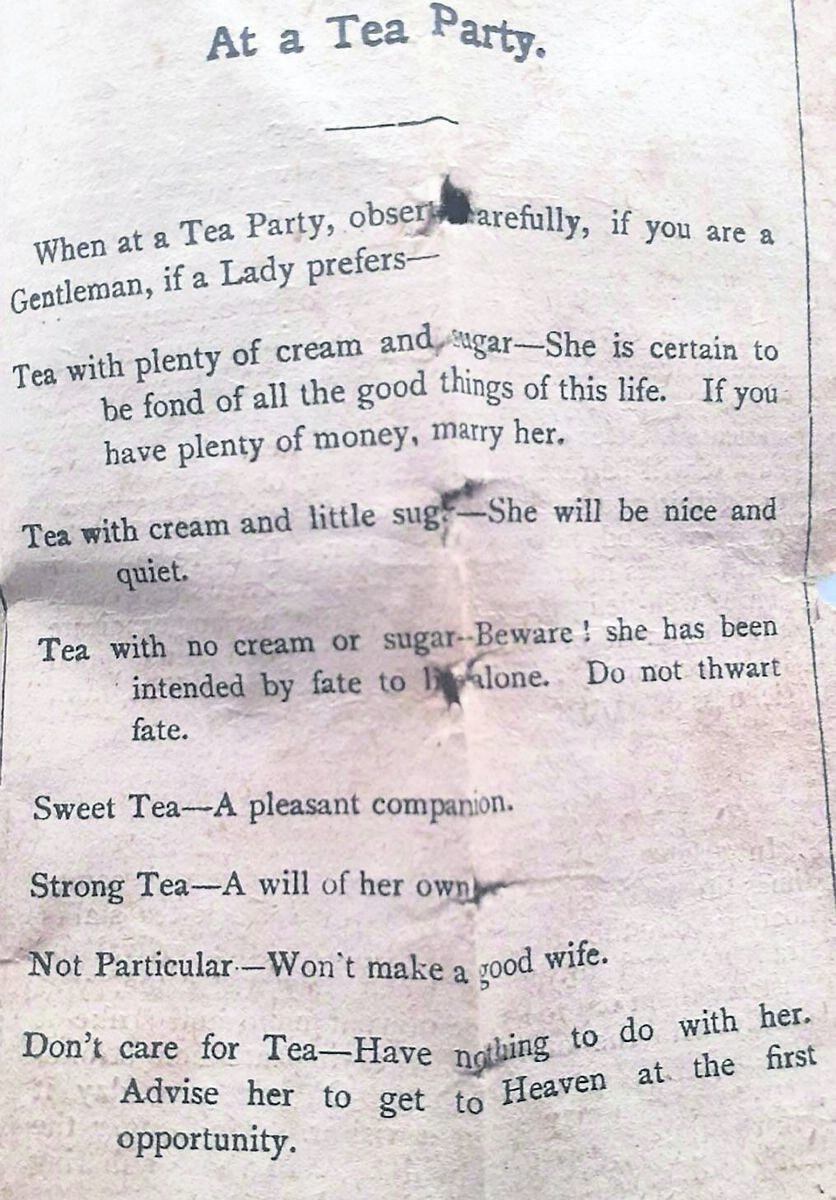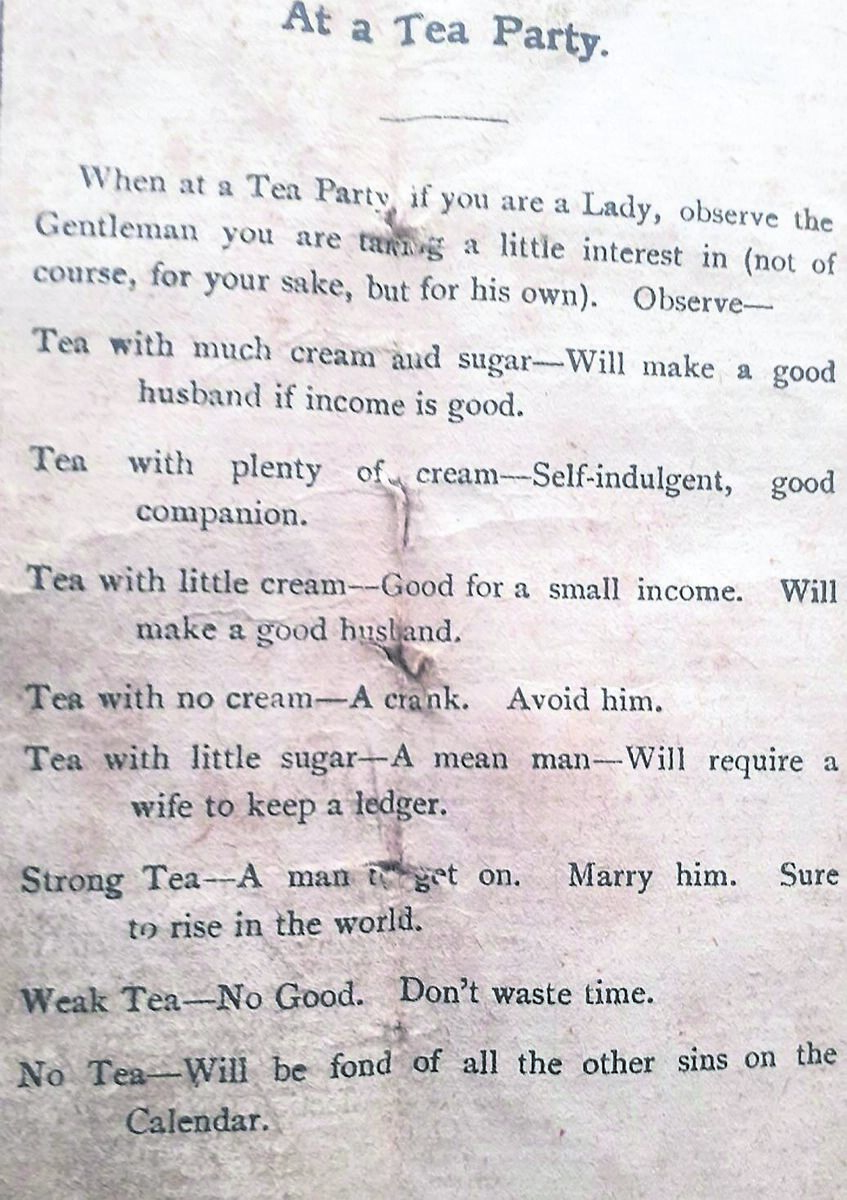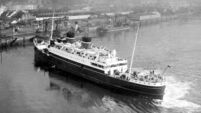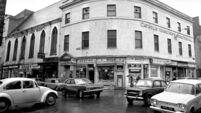Throwback Thursday: Stirring stuff! My nan would read tea leaves

Throwback Thursday is written by Jo Kerrigan.
WE have had a huge response to our recent Throwback Thursday articles about the topic of today’s food waste, in contrast to our thrifty forbears using up every leftover: we clearly touched a strong chord.
Here is one reply from reader Michael Ryan which also includes a rare hint on the dark skill of reading tea leaves!
“Hi Jo. I was reading your piece about food items on Throwback Thursday. It brought back a lot of memories to me.
“My grandmother was a great cook, she would make the soda bread which was like cake. Her scones were like quarter pounders, and she would offer you jam on them, which was homemade, as well as butter, whatever you preferred.
She had the open fire and everything was cooked in the old cast iron pots and kettle.
Michael continues: “The tea was loose then, and when it was poured, you would have a silver tea strainer to remove the tea leaves. I well remember that my Nan had a tea book that she would consult carefully so that she could read the tea leaves at the bottom of your cup when you finished your tea.
“I still treasure that book, and although it’s battered and torn after a well-used life, some pages are still readable.”

We reproduced some of the pages here.
Michael adds: “I remember the milk coming in a glass bottle, with a silver cap. On removing the cap, you had the cream on top. My grandfather and some of my uncles worked in the local creamery at some stage, so the dairy products were nice and fresh.
“I would think the milk tasted nicer in a glass bottle then, not like today in a plastic bottle. What do other readers think?”
Gosh, Michael, you have a good query there. And does anybody remember when milk was delivered to your own container, from the churn on the truck driven by the milkman? You could skim the cream off that too.
Nowadays, of course, it’s all homogenised and blended and you can’t separate the two out as they did in the olden days in dairies, to make the butter.

Now, do you remember we talked a while back about the great little Sirius, which battled across the Atlantic to New York under the captainship of Richard Roberts, becoming the first steamship ever to make that crossing?
It beat Brunel’s Great Western by a day, if you recall, doubtless causing some severe tooth grinding on board the latter ship as it arrived only to see the smug little Sirius already ensconced and receiving the accolades.
Well, we have had an email from nowhere else than Trinity College in Dublin. From Dr Jane Maxwell, to be precise, curator of the Manuscripts Collection there.
“I enjoyed your Throwback Thursday item referring to Richard Roberts. I am sure you would be interested to read our blog post concerning the Roberts logbook purchased recently by Trinity College Library and available to all interested parties to consult.”
Well, we were, Jane, we certainly were! And we take the liberty of reproducing it here, since many want to know more about this doughty hero.
WHAT’S IN A NAME? RICHARD ROBERTS, CORK’S NAVAL HERO
A chance discovery of an incorrectly described journal has led to the revelation of a story of adventure and heroism, almost lost to history. The story turns on the mis-identification of the author’s name. In developing the Library’s collection of unique manuscript material, some items are identified as desirable because of the identity of the author, whereas some are attractive because the type of record they represent is one which the Library collects. Ships’ logs are an example of the latter category.
“A recent addition to this collection turned out on closer inspection to have been more than usually worth retrieving from the overcrowded mists of time where its significance was about to be obscured due to a misreading of the name of the author.
The sales catalogue listed the item as being the naval account book of Sir Richard Rokeby, on board the HMS Eden off the coast of Africa in 1830. The unknown Rokeby was not a person of interest to us, but the account book itself was.
However, further research undertaken when the item arrived into the Library revealed that the author was in fact Lieutenant Richard Roberts, a Cork man with a polished reputation.
Richard (1803-41) was the son of Richard Roberts, a Justice of the Peace from Cork, and his Clare-born second wife Mary Anne Neville D’Esterre.
Richard junior joined the Royal Navy as a gentleman volunteer in his early teens and served on the West African station during the British Navy’s campaign against the traffic in enslaved persons in the years between 1807 (Abolition of the Slave Trade Act ) and 1833 (Slavery Abolition Act). The little account book that appeared to be quite a humble record of the wages paid both to Roberts, and by him to his servants during the 1830s, was in fact something much more interesting.
One entry records the receipt of money by Roberts for service on 1 Feb, 1829. That was the day when, as senior mate serving on the Black Joke and due to the incapacity of his commanding officer Lieutenant Henry Downes, Roberts commanded the ship in an encounter with a Spanish slaving ship, the Almirante, bound from Lagos River to Havanna with 466 enslaved persons.
Following ‘a long chase and severe action’, Roberts led a boarding party which captured the Almirante and freed the captives (of whom 39 died shortly thereafter).
The Black Joke had itself formerly been a slaving ship called the Henriquetta which had been captured in 1828. In its career it captured 21 slaving ships in total, with upwards of 7000 enslaved individuals in them. It was not evenly matched against the Almirante on that fateful day in 1829; it had 2 guns and 55 men while the Almirante had 14 guns and 80 men.
The action included an eleven hours’ chase and eighty minutes’ of ‘severe action’, in which the enemy had 15 killed and 13 wounded, and the British had 3 killed and 7 wounded, including Roberts.
Roberts was promoted to lieutenant for his part in this action but, due to reductions in the size of the Royal Navy, was put on half-pay in 1830.
This was not the end of Roberts’ derring do. Back in Cork he held several short-term commands on cross-channel steam packets. In 1836 he was working for the St George Steam Packet Company in command of the Victory.
In the competition to establish a steamship route between UK and America in 1838, Roberts was appointed commander of the Sirius. An attempt at an Atlantic crossing by the undersized Sirius was considered a very risky endeavour and Roberts was in competition with the SS Great Western, designed by Isambard Kingdom Brunel, the first steamship purpose-built for the crossing of the Atlantic and the largest passenger ship in the world in 1837.
However, our man from Cork proved successful, arriving in New York a day before the Great Western. News of the arrival of the Sirius became headline news in American newspapers and Roberts was greeted as a celebrity.
On 1 May he began the journey home, thousands turning out to see the Sirius off while the Battery fired a seventeen-gun salute. After a rough crossing, he arrived in Falmouth on 18 May, and on his return to Cork was presented with a silver service, a memorial address, and the freedom of Cork city.
Robert married (September 1837) Jane (d. 1882), daughter of William Johnson of Rockenham, Passage West. They had one son, Maj. Richard Roberts.
In February, 1841, Roberts commanded the President in a crossing to New York, beginning his return journey in March. He himself believed the ship to be unseaworthy and he was correct. It was never seen again and it was later concluded that she had sunk in mid Atlantic during a storm, Roberts, his crew, and the passengers all being drowned.
A memorial was erected to his memory in the churchyard in Passage West, on the four sides of which were depictions of the ships he had commanded.
In 1988, on the 150th anniversary of the trans-Atlantic voyage, a monument to Roberts was unveiled in Passage West and An Post issued a commemorative stamp.
Dr Maxwell, thank-you so very much for taking the trouble to alert us to the existence of this fascinating logbook. Who will be the first to head up to Trinity and consult it?
Do I hear someone enquiring how Trinity knew about Throwback Thursday? Sure, doesn’t the whole country read it?! And further afield too. We’ve had correspondence from the UK, the US, Germany, Australia, and even the Himalayas. Isn’t it famous? Of course it is!
And now to another famous Corkonian.
We were all delighted with Cillian Murphy’s success at the Oscars (and did you see the witty objections on social media regarding Ireland (and by default, Dublin) having the colossal cheek trying to claim him as one of their own, when he was, is, and ever will be a Cork boy and nothing else?!
It’s true - officially we are one country, but tap us and the native divisions flare up instantly. Mostly we see it in sports, but the Oscars triumph brought it bubbling forth too.

The happy occasion reminded Michael Ryan of a rather nice family story: “It was great to see Cillian Murphy receiving his Oscar for the film Oppeinheimer. It brought back memories of my mam and dad going on a holiday to New York.
“The story starts with my father having an aunt who was a nanny for the film director George Roy Hill’s family. Hill, you may recall, got an Oscar for best director in the film The Sting.
“My father’s aunt was Annie Norris. She lived on 5th Avenue, and would be seen cycling all over the place into her late years, that’s what me dad said. She had her own apartment, and would go everywhere with George on set, and cook for him and his family.
Without fail, she would send dollars over to my father for his birthday every year.
“I met her once when she came to visit us in Fair Hill. I had just done the marathon. On mentioning it, she said, ‘Why don’t you come over and run in the New York marathon? Sure, you can stay in my apartment!’
“In the event, my sister and her husband went to visit Annie with mam and dad. They headed for Rockefeller Centre on 5th Avenue. Dad said there were two blocky fellas on the lift, suited and booted, with guns. They were allowed to go up, and George Roy Hill welcomed them in. He poured whiskies for them, raised a glass, and said Slainte. He then showed them his Oscar and his World War II memorabilia.
“My sister thought she would get to hold the Oscar, but he said it never left its locked glass cabinet. However, he said they could take as many photographs as they wanted, and ‘you just missed out on meeting Paul Newman, he was in earlier!’
“After they said their goodbyes to George, they went with Annie to her adjacent apartment to catch up on things. They had a fabulous holiday, and caught up with other friends and families too, in Brooklyn.
Incidentally, my dad told me I was born the very same year as Mickey Mouse, and he was absolutely right!
“Now, this year is the 50th anniversary of the release of The Sting, and it will rekindle many memories of my family’s trip.”
Share your memories with us! Email jokerrigan1@gmail.com. Or leave a comment on our Facebook page: https://www.facebook.com/echolivecork







